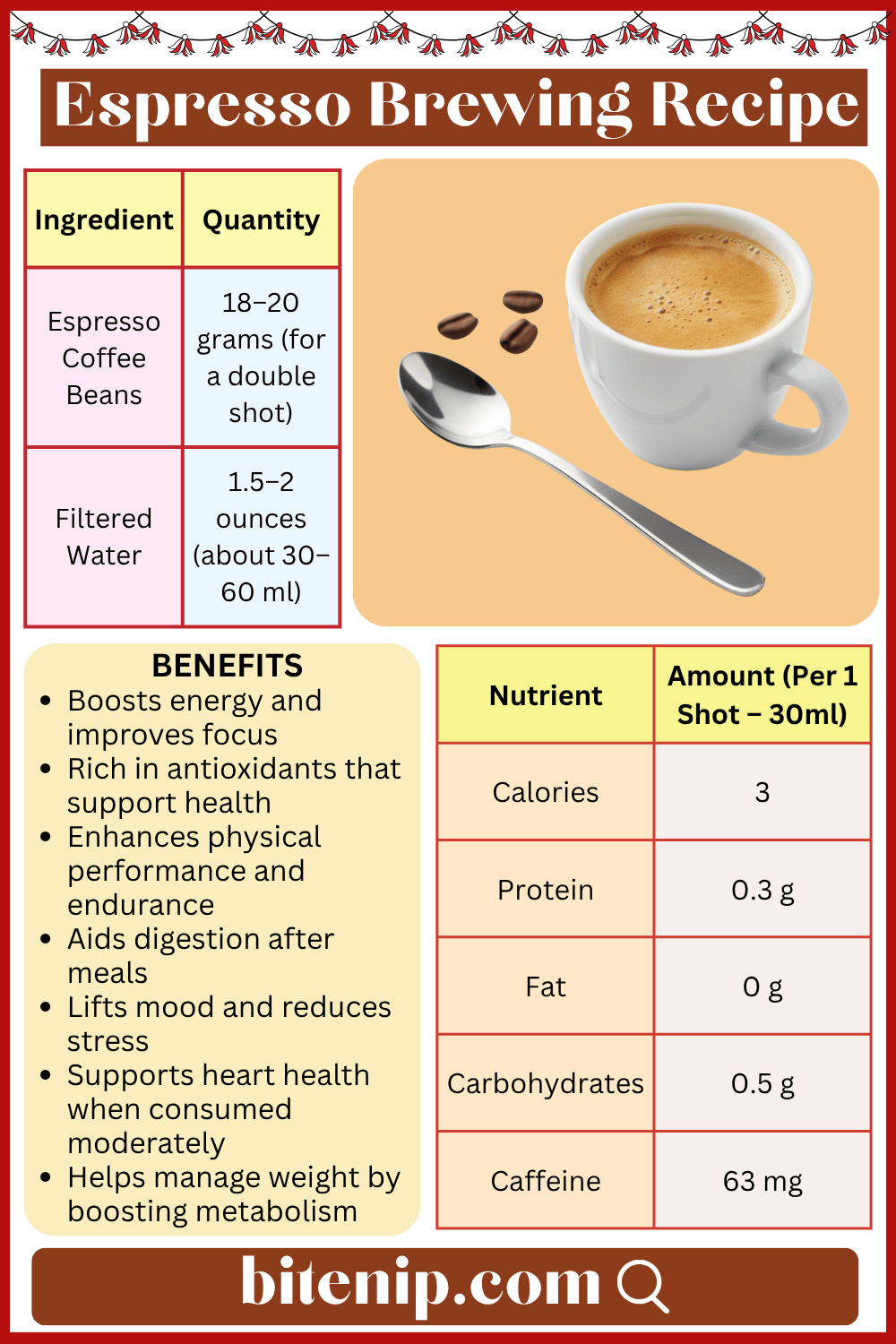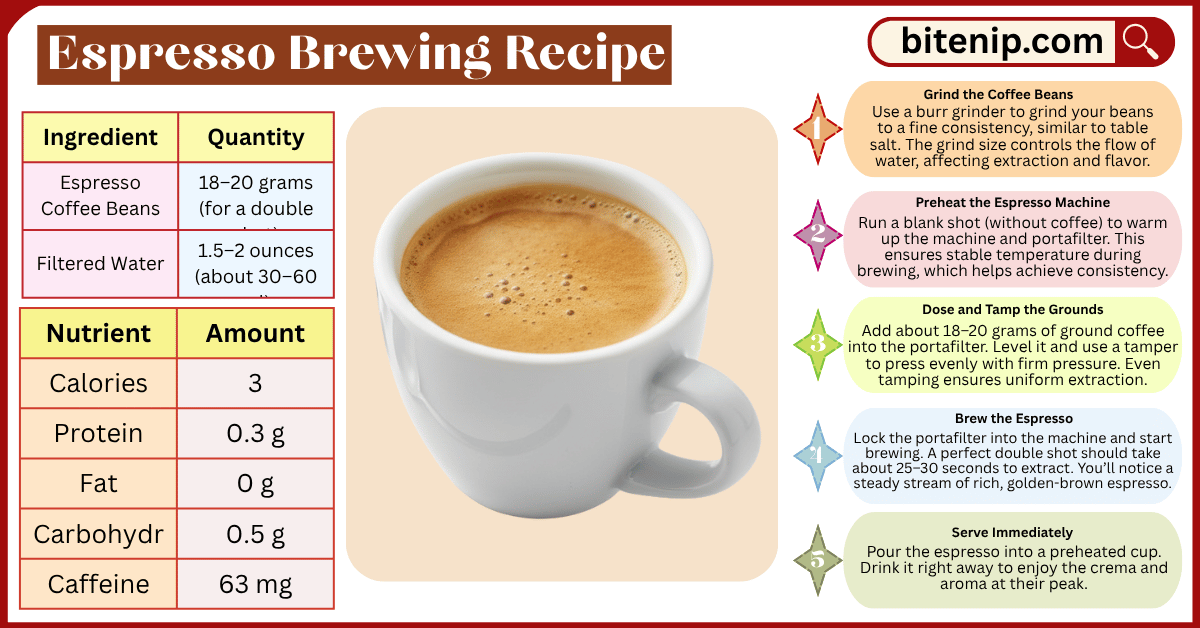Espresso is the heart of countless coffee drinks and a favorite among coffee lovers for its rich aroma, smooth texture, and intense flavor. This small but powerful beverage delivers a concentrated burst of caffeine and taste. Making the perfect espresso requires precision, patience, and the right technique. In this guide, you’ll learn how to make espresso at home like a professional barista using the right ingredients, tools, and steps.
Origin of Espresso
The word espresso comes from Italy, meaning “pressed out,” referring to how hot water is forced through finely ground coffee beans under high pressure. This process was invented in the early 1900s when Italian engineer Luigi Bezzera created a machine to make quick, flavorful coffee for busy workers. Over time, espresso became the foundation for many drinks like cappuccino, latte, and macchiato. Today, it’s celebrated worldwide as both a drink and an art form.
Ingredients of Espresso Recipe with pictures
- Espresso Beans
Espresso beans are roasted darker than regular coffee beans, which gives them a strong flavor and low acidity. They’re the base of your espresso and directly affect taste, aroma, and crema.

- Filtered Water
Water makes up nearly 90% of espresso, so its quality is crucial. It should be filtered, clean, and free from impurities to ensure a smooth, balanced shot.

Ingredients with Quantity
| Ingredient | Quantity |
|---|---|
| Espresso Coffee Beans | 18–20 grams (for a double shot) |
| Filtered Water | 1.5–2 ounces (about 30–60 ml) |
Step by Step Espresso Brewing Recipe
Step 1: Grind the Coffee Beans
Use a burr grinder to grind your beans to a fine consistency, similar to table salt. The grind size controls the flow of water, affecting extraction and flavor.
Step 2: Preheat the Espresso Machine
Run a blank shot (without coffee) to warm up the machine and portafilter. This ensures stable temperature during brewing, which helps achieve consistency.
Step 3: Dose and Tamp the Grounds
Add about 18–20 grams of ground coffee into the portafilter. Level it and use a tamper to press evenly with firm pressure. Even tamping ensures uniform extraction.
Step 4: Brew the Espresso
Lock the portafilter into the machine and start brewing. A perfect double shot should take about 25–30 seconds to extract. You’ll notice a steady stream of rich, golden-brown espresso.
Step 5: Serve Immediately
Pour the espresso into a preheated cup. Drink it right away to enjoy the crema and aroma at their peak.

Common Mistakes to Avoid
- Using the Wrong Grind Size
If the grind is too coarse, water flows too quickly, and your espresso tastes weak. Too fine, and it becomes bitter and over-extracted. Adjust your grinder carefully. - Ignoring Water Quality
Tap water often contains minerals or chlorine that can alter the flavor. Always use filtered water for the best results. - Incorrect Tamping Pressure
Uneven tamping leads to channeling, where water passes through weak spots, resulting in poor extraction. Consistency is key. - Not Cleaning the Machine
Old coffee oils and residue can ruin the taste. Clean your portafilter and group head regularly to maintain flavor purity.
Expert Tips for the Best Espresso Recipe
- Use Freshly Roasted Beans
Always grind fresh beans just before brewing. Coffee starts losing aroma minutes after grinding. - Preheat Everything
Warm your machine, portafilter, and cup. Temperature consistency helps preserve crema and taste. - Experiment with Ratios
If you prefer stronger espresso, try a smaller water ratio. Adjust extraction time and dose until you find your perfect balance. - Watch the Extraction Time
Too fast means under-extraction; too slow means over-extraction. Aim for a steady 25–30-second brew. - Espresso Variations
- Ristretto
A shorter extraction using less water but the same amount of coffee. It’s thicker and more intense in flavor. - Lungo
Uses more water for a longer extraction, producing a milder, slightly bitter espresso. - Macchiato
A shot of espresso topped with a small amount of foamed milk for a balanced taste. - Americano
Dilute espresso with hot water for a smoother, lighter drink that resembles drip coffee.
Serving Suggestions
Serve espresso immediately after brewing in a small, preheated demitasse cup. It’s best enjoyed plain to appreciate the rich crema, but you can pair it with biscotti or dark chocolate for a traditional Italian touch. Some also enjoy a glass of sparkling water before or after to cleanse the palate.
Nutritional Information
| Nutrient | Amount (Per 1 Shot – 30ml) |
|---|---|
| Calories | 3 |
| Protein | 0.3 g |
| Fat | 0 g |
| Carbohydrates | 0.5 g |
| Caffeine | 63 mg |
Why People Love Espresso Recipe ?
People love espresso for its strong aroma, instant energy boost, and the ritual of brewing it. It’s compact yet powerful, delivering deep flavor in every sip. Moreover, it’s versatile, forming the base for dozens of drinks while offering a sense of sophistication and comfort.
Benefits of Espresso Recipe
1. Boosts Energy and Alertness
Espresso contains concentrated caffeine, which stimulates the central nervous system and helps you stay focused and awake. A single shot can quickly increase mental clarity, making it ideal for busy mornings or long work sessions.
2. Rich in Antioxidants
Espresso is packed with antioxidants such as polyphenols, which help fight free radicals in the body. These antioxidants support overall cell health and can reduce the risk of certain chronic diseases.
3. Improves Physical Performance
The caffeine in espresso enhances endurance and strength by increasing adrenaline levels in the blood. Many athletes drink a shot before workouts to improve focus and energy.
4. Supports Heart Health (in Moderation)
Studies suggest that moderate espresso consumption can improve blood circulation and may help maintain heart health by reducing inflammation. However, excessive intake can have the opposite effect, so balance is key.
5. Aids Digestion
Drinking espresso after a meal can help stimulate the digestive system. Italians often enjoy it as a post-meal drink because it helps reduce bloating and promotes faster digestion.
6. Enhances Mood
Espresso can lift your mood by boosting dopamine levels in the brain. It creates a feeling of satisfaction and happiness, helping to reduce stress and mental fatigue.
7. May Help with Weight Management
Caffeine slightly increases metabolism, which can help the body burn calories more efficiently. When consumed without sugar or cream, espresso is almost calorie-free and fits well into a healthy diet.
Disadvantages of Espresso Recipe
1. Can Cause Sleep Disturbances
Because espresso contains concentrated caffeine, drinking it too late in the day can interfere with sleep patterns. It may take several hours for caffeine to leave your system, so it’s best to avoid it in the evening.
2. May Increase Anxiety or Restlessness
High doses of caffeine can overstimulate the nervous system, causing jitteriness, nervousness, or rapid heartbeat, especially in people sensitive to caffeine.
3. Can Lead to Stomach Irritation
Espresso is acidic and may cause discomfort for people with acid reflux, gastritis, or sensitive stomachs. Drinking it on an empty stomach can increase acidity levels.
4. Risk of Dependence
Regular high consumption can make your body dependent on caffeine, leading to withdrawal symptoms like headaches, irritability, or fatigue when you skip your daily cup.
5. May Raise Blood Pressure Temporarily
Caffeine can cause a short-term increase in blood pressure, which may be concerning for people with hypertension. While the effect is usually temporary, those with cardiovascular issues should monitor their intake.
6. Can Cause Dehydration
Espresso has a mild diuretic effect, meaning it can increase urination and fluid loss. Without enough water intake, this can lead to dehydration over time.
7. Can Stain Teeth
Over time, espresso’s dark color and acidity can lead to staining or yellowing of teeth. Regular dental care and rinsing your mouth with water afterward can help prevent discoloration.
FAQs
1. Can I make espresso without a machine?
Yes, you can use a Moka pot or AeroPress for a similar strong brew.
2. What’s the perfect espresso ratio?
A common ratio is 1:2, meaning 18 grams of coffee for about 36 grams of espresso.
3. Why is my espresso bitter?
Over-extraction or too fine a grind often causes bitterness.
4. How long should extraction take?
Ideally, between 25–30 seconds for a balanced flavor.
5. What’s crema?
It’s the golden foam on top of espresso formed by coffee oils and air. It indicates freshness and good extraction.
6. Can I use regular coffee beans?
Yes, but espresso-roasted beans give better flavor and texture.
7. How do I store espresso beans?
Keep them in an airtight container away from light and moisture.
8. Why does my espresso have no crema?
Old beans or low pressure can cause poor crema formation.
9. Is espresso stronger than regular coffee?
Per ounce, yes. Espresso is more concentrated in caffeine and flavor.
10. How many shots of espresso are safe per day?
Most adults can safely consume up to 3–4 shots daily, depending on caffeine tolerance.
Conclusion
Espresso is more than a coffee; it’s a craft that combines science, skill, and passion. By mastering grind size, temperature, and timing, anyone can enjoy barista-quality espresso at home. Whether you like it short, long, or with milk, every cup tells a story of Italian tradition and modern taste. So, brew with care, savor every sip, and let your day begin with the perfect shot of espresso.

